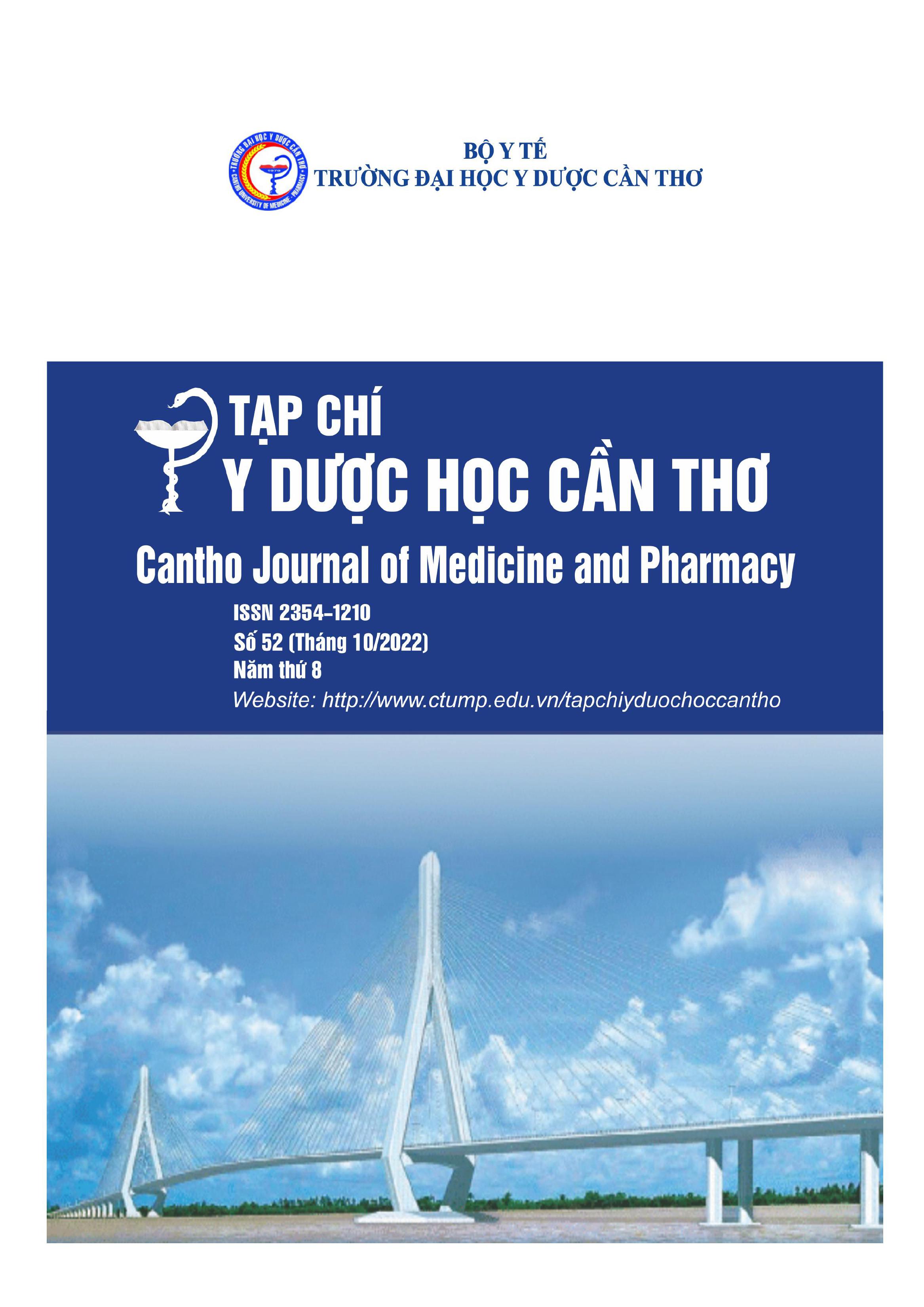CLINICAL CHARACTERISTICS, THE TEMPOROMANDIBULAR JOINT ON CONE-BEAM COMPUTED TOMOGRAPHY (CBCT) AND ASSESSMENT OF TEMPOROMANDIBULAR DISORDERS TREATMENTS AT THE HOSPITAL OF CAN THO UNIVERSITY OF MEDICINE AND PHARMACY IN 2021-2022
Main Article Content
Abstract
Background: Temporomandibular disorder (TMD) is a fairly common disease, affecting the quality of life of patients. To evaluate the treatment outcome toward temporomandibular disorder with occlusal splint, we conducted this study. Objectives: Description of clinical features, images of the temporomandibular joint on cone-beam computed tomography (CBCT) in patients with temporomandibular disorders and evaluation of treatment results with stable occlusal splint. Materials and methods: A cross-sectional descriptive study with clinical intervention was carried out to evaluate treatment outcome before and after intervention. Results: The female-to-male ratio of patients with signs and symptoms of temporomandibular disorder was 4:1. The signs and symptoms occupied the highest proportion were pain (100%), followed by joints sounds (82.9%), decreased amplitude of mouth opening (48.6%). The condylar position was in posterior side with 67.5% of cases. After 6 months of treatment: 34.3% and 65.7% of patients showed a high and average reduction of pain respectively, 100% of patients showed a good improvement in mouth opening amplitude, 96.6% and 3.4% of patients showed an average and high decrease of joint sound, respectively. Conclusion: Temporomandibular disorder is more common in women than in men, the main symptom that patients come for treatment is joint pain. The condyle morphology on cone-beam computed tomography film is round and in posterior position. After 6 months of treatment with occlusal splint, 100% of patients responded to the treatment regarding pain, limitation in mouth opening and joint sound. The position of the mandibular condyle in the group with central position increased by 60%.
Article Details
Keywords
Temporomandibular disorders (TMD), treatment, occlusal splint
References
2. Nguyễn Văn Lân (2018), Đặc điểm hình thái khớp thái dương hàm không triệu chứng ở người Việt trưởng thành nghiên cứu trên hình ảnh cắt lớp điện toán chùm tia nón, Luận án Tiến sĩ y học, Trường Đại học Y Dược Thành Phố Hồ Chí Minh.
3. Lương Thảo Nguyên, Trần Thị Nguyên Ny và cs (2013), Tình hình điều trị rối loạn thái dương hàm tại khoa Răng Hàm Mặt – Đại học Y Dược TPHCM từ năm 2008 đến 2010, Tạp chí Y học TPHCM, 17, tr. 66-71.
4. Nguyễn Phúc Diên Thảo, HoàngTử Hùng (2006), Rối loạn thái dương hàm, Tạp chí Y học Hồ Chí Minh, 8(4), tr. 23-30.
5. Nguyễn Mạnh Thành (2013), Đánh giá kết quả điều trị rối loạn thái dương hàm bằng máng nhai ổn định, Luận văn tốt nghiệp bác sĩ nội trú, Trường Đại học Y Hà Nội.
6. Dawson P. (2004), The Concept of Complete Dentistry, Mosby Elsevier.
7. Edward F.Wright (2010). Manual of Temporomandibular Disorder, Wiley Blackwell NewYork, pp.67-89.
8. Ikeda K., Kawamura A. (2009), Assessment of optimal condylar position with limited cone-beam computed tomography, American Journal of Orthodonticsand Dentofacial Orthopedics, 135 (4), pp.495-501.
9. Imanimoghaddam M., Madani A. S., Mahdavi P., Bagherpour A., Darijani M., et al. (2016), “Evaluation of condylar positions in patients with temporomandibular disorders: A cone-beam computed tomographic study”, Imaging Science in Dentistry, 46 (2), pp.127-31.
10. James Fricton (2007). Myogenous Temporomandibular Disorders: Diagnostic and Management Considerations.Dent Clin N Am, 51, pp.61-83.
11. Komine, A. Hugger (2004). Efficacy of stabilization splints for the management of patients with masticatory muscle pain, Clin Oral Invest, 8, pp.179-195.
12. Kijima N., Honda K., Kuroki Y., Sakabe J., Ejima K., et al. (2007), Relationship between patient characteristics, mandibular head morphology and thickness of the roof of the glenoid fossa in symptomatic temporomandibular joints, Dentomaxillofacial Radiology, 36 (5), pp.277-281.
13. Melita VP (2010). Temporomandibular Disorders - Problems in Diagnostics. Medical Science, 34, pp.11-32.
14. Scrivani S J., et al. (2008), Temporomandibular disorders. N Engl J Med, 359(25), pp.2693-2702.


